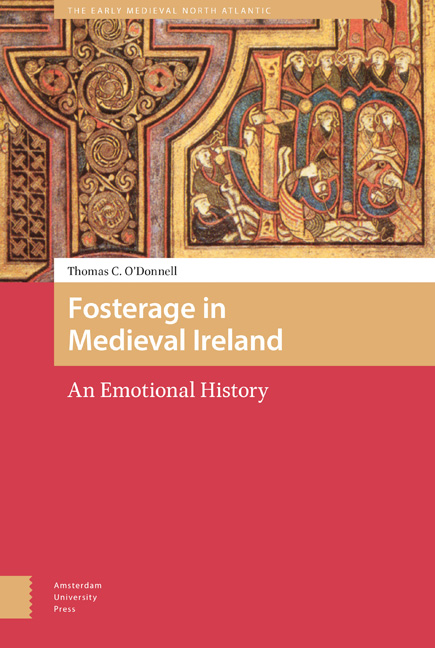Book contents
- Frontmatter
- Dedication
- Contents
- Abbreviations
- Acknowledgements
- Introduction
- 1 Cú Chulainn and Expressions of Foster Fatherhood
- 2 Who Makes a Foster Sibling?
- 3 Identity within Fosterage
- 4 Fosterage in the Medieval Irish Church
- 5 Animal Fosterage: A Bestial Parallel?
- Conclusion
- Bibliography
- About the Author
- Index
- Frontmatter
- Dedication
- Contents
- Abbreviations
- Acknowledgements
- Introduction
- 1 Cú Chulainn and Expressions of Foster Fatherhood
- 2 Who Makes a Foster Sibling?
- 3 Identity within Fosterage
- 4 Fosterage in the Medieval Irish Church
- 5 Animal Fosterage: A Bestial Parallel?
- Conclusion
- Bibliography
- About the Author
- Index
Summary
As Charles-Edwards has said, ‘[F]osterage belonged more to the emotional sphere, less to the material, than did natural parenthood.’ In this book I have examined how foster families interacted within that emotional sphere and what difference that made within a literary tradition so heavily indebted to the legal and material aspects of relationships. The emotional community of fosterage in Ireland was represented in texts current during the eleventh and twelfth centuries. From my study a picture has emerged of fosterage created by emotional, nutritive and educational ties. Fosterage was a means to understand relationships created outside the natal family, at a young age, reinforced by shared experience. These bonds lasted throughout the lives of those involved. Yet, many of the examples of fosterage examined fall outside the medieval Irish legal definition of fosterage. The picture of the emotional community that is created by examining narrative literature is slightly different from that created in the law texts. The narrative texts show us a fosterage based on affection, an altram serce if you will, that still affects how relationships function, even if the fosterage is not legally recognised. In these instances the foster relationship is distinct, it is not friendship or a teacher/pupil relationship but has a different emotional tenor. Fictive kin bonds are created in this emotional sphere. For this reason, we see fosterage describing relationships among the fían, between saints and the divine, and even between humans and wolves. Each chapter has addressed a different question in relation to the foster family and the emotional community that it creates.
Before we can create a history of the emotions of fosterage, we have to resolve a tricky definitional problem. Previous social histories of this kind have focused on the emotions displayed within the family. The relationships within a family are easier to define; who is a father and mother has something of a biological necessity about it. Fosterage falls into the penumbra of fictive kinship, along with sworn-brother, stepfamily, and spiritual kin. Before we can outline the emotional ties within this unit, we need to define who forms part of the foster family.
- Type
- Chapter
- Information
- Fosterage in Medieval IrelandAn Emotional History, pp. 205 - 216Publisher: Amsterdam University PressPrint publication year: 2020

